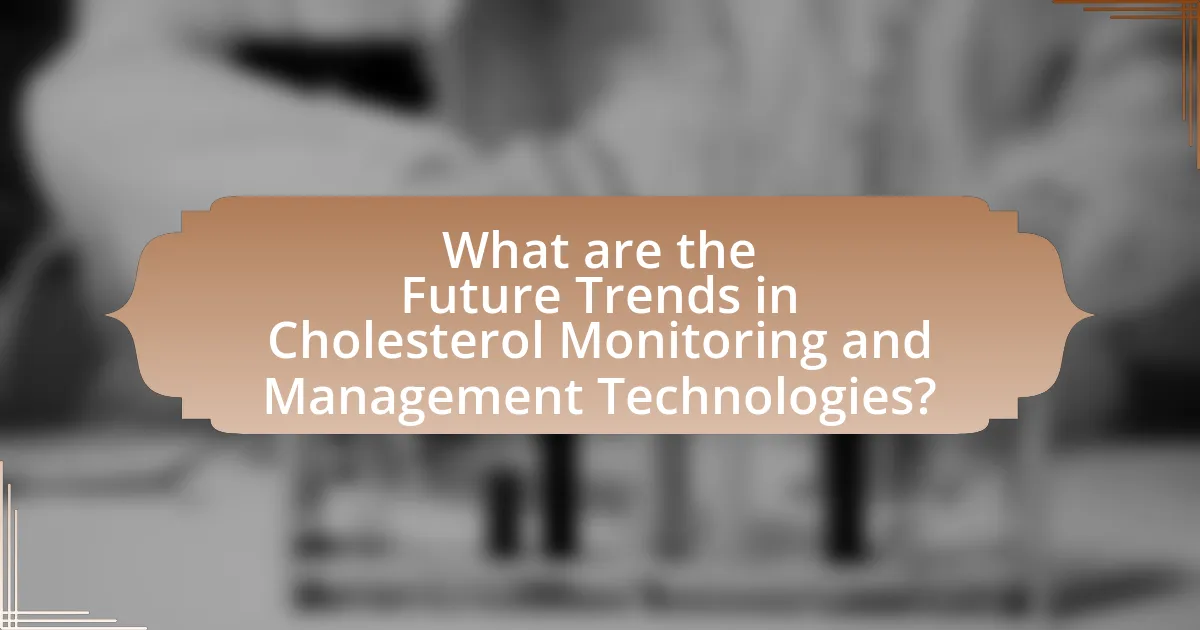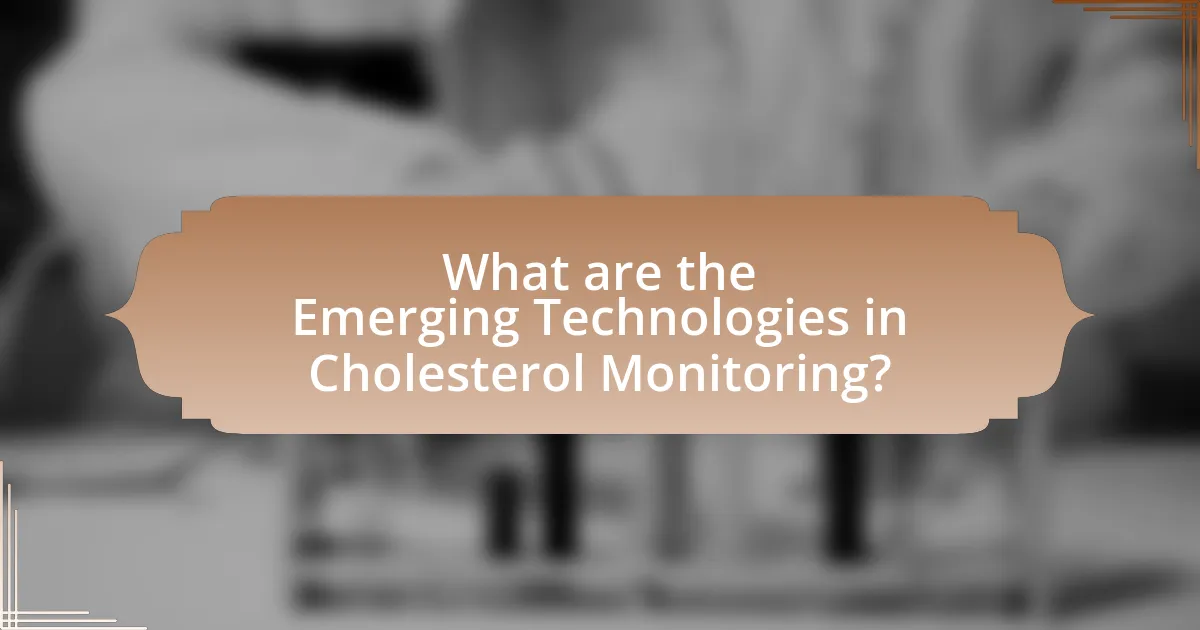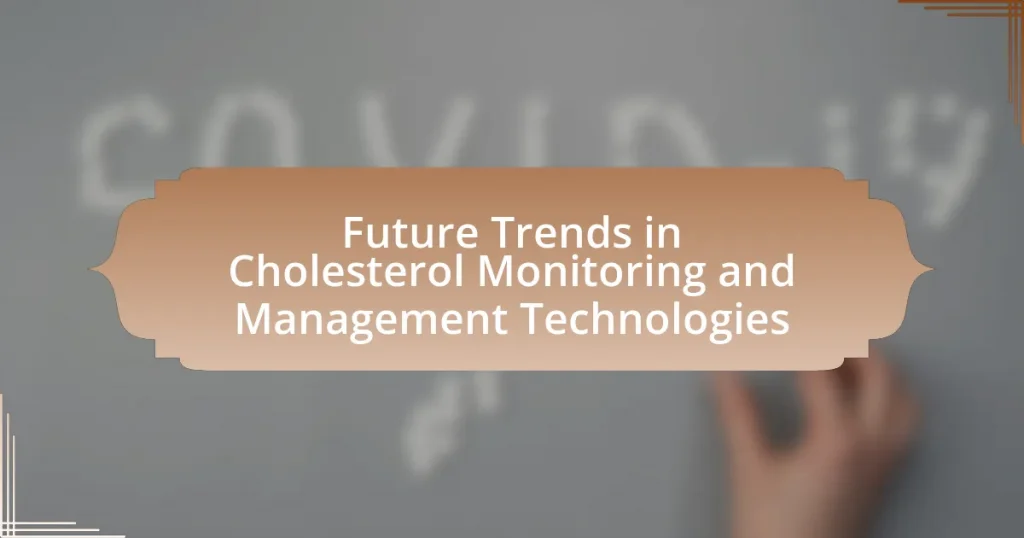The article focuses on future trends in cholesterol monitoring and management technologies, highlighting advancements such as wearable devices, advanced biosensors, and telehealth solutions. It discusses how these innovations enhance real-time tracking of cholesterol levels, improve accuracy and convenience, and facilitate personalized treatment plans through data analytics. The article also examines the role of patient engagement, mobile applications, and emerging technologies in improving cholesterol management, while addressing challenges related to technology adoption, regulatory issues, and the need for personalized medicine. Overall, it emphasizes the importance of integrating these technologies into healthcare systems to optimize cholesterol care and improve patient outcomes.

What are the Future Trends in Cholesterol Monitoring and Management Technologies?
Future trends in cholesterol monitoring and management technologies include the development of wearable devices, advanced biosensors, and telehealth solutions. Wearable devices, such as smartwatches, are increasingly integrating cholesterol monitoring capabilities, allowing for continuous tracking of lipid levels in real-time. Advanced biosensors are being designed to provide more accurate and rapid cholesterol measurements using minimal blood samples, enhancing user convenience and compliance. Telehealth solutions are expanding access to healthcare professionals for personalized cholesterol management, enabling remote consultations and tailored treatment plans. These trends are supported by research indicating that wearable technology can improve health outcomes by promoting proactive health management and adherence to treatment protocols.
How are advancements in technology shaping cholesterol monitoring?
Advancements in technology are significantly enhancing cholesterol monitoring through the development of portable devices and digital health applications. These innovations allow for real-time tracking of cholesterol levels, enabling individuals to monitor their health more conveniently and accurately. For instance, devices like fingerstick blood tests and wearable sensors provide immediate results, reducing the need for laboratory visits. Additionally, mobile applications can analyze data trends and offer personalized health recommendations, which is supported by studies showing that continuous monitoring leads to better management of cholesterol levels and overall cardiovascular health.
What new devices are being developed for cholesterol measurement?
New devices being developed for cholesterol measurement include portable biosensors and smartphone-integrated testing kits. These innovations aim to provide rapid, accurate cholesterol readings outside of traditional clinical settings. For instance, research has shown that biosensors utilizing microfluidic technology can deliver results in minutes with minimal blood samples, enhancing accessibility and convenience for users. Additionally, smartphone-integrated devices leverage mobile applications to analyze cholesterol levels, allowing for real-time monitoring and personalized health management. These advancements reflect a significant trend towards more user-friendly and efficient cholesterol monitoring solutions.
How do these devices improve accuracy and convenience?
Cholesterol monitoring devices improve accuracy and convenience by utilizing advanced biosensors and real-time data analytics. These technologies enable precise measurements of cholesterol levels with minimal user intervention, reducing human error associated with traditional methods. For instance, devices like continuous glucose monitors adapted for cholesterol tracking can provide instant feedback, allowing users to make informed health decisions promptly. Studies have shown that such devices can enhance adherence to monitoring protocols, leading to better management of cholesterol levels and overall cardiovascular health.
What role does data analytics play in cholesterol management?
Data analytics plays a crucial role in cholesterol management by enabling healthcare providers to analyze patient data for personalized treatment plans. Through the examination of large datasets, including patient demographics, lifestyle factors, and historical cholesterol levels, data analytics identifies trends and risk factors associated with high cholesterol. For instance, studies have shown that predictive analytics can forecast cardiovascular risks based on cholesterol levels and other health indicators, allowing for timely interventions. Additionally, data analytics supports the monitoring of treatment efficacy by tracking changes in cholesterol levels over time, thus facilitating adjustments in medication or lifestyle recommendations.
How can big data enhance personalized cholesterol treatment plans?
Big data can enhance personalized cholesterol treatment plans by analyzing vast amounts of patient data to identify individual risk factors and treatment responses. This analysis allows healthcare providers to tailor interventions based on genetic, lifestyle, and clinical data, leading to more effective management of cholesterol levels. For instance, studies have shown that utilizing big data analytics can improve the prediction of cardiovascular events by up to 30%, enabling more precise treatment adjustments. By integrating data from electronic health records, wearable devices, and genomic information, clinicians can develop customized strategies that optimize medication dosages and dietary recommendations, ultimately improving patient outcomes.
What are the implications of predictive analytics in cholesterol management?
Predictive analytics significantly enhances cholesterol management by enabling personalized treatment plans and early intervention strategies. By analyzing large datasets, including patient history, genetic factors, and lifestyle choices, predictive models can identify individuals at high risk for cholesterol-related issues, allowing healthcare providers to tailor interventions accordingly. For instance, a study published in the Journal of the American College of Cardiology demonstrated that predictive analytics could improve patient outcomes by 20% through targeted lifestyle modifications and medication adherence strategies. This data-driven approach not only optimizes treatment efficacy but also reduces healthcare costs by preventing severe cardiovascular events associated with high cholesterol levels.
Why is patient engagement important in cholesterol management technologies?
Patient engagement is crucial in cholesterol management technologies because it directly influences treatment adherence and health outcomes. Engaged patients are more likely to understand their condition, follow prescribed interventions, and utilize monitoring tools effectively. Research indicates that higher levels of patient engagement can lead to a 20% improvement in adherence to cholesterol-lowering medications, which is essential for reducing cardiovascular risks. Furthermore, technologies that facilitate patient engagement, such as mobile health apps and telehealth services, have been shown to enhance communication between patients and healthcare providers, fostering a collaborative approach to managing cholesterol levels.
How can mobile applications facilitate better cholesterol monitoring?
Mobile applications can facilitate better cholesterol monitoring by enabling users to track their cholesterol levels, receive personalized dietary recommendations, and connect with healthcare professionals in real-time. These applications often include features such as logging blood test results, setting reminders for medication, and providing educational resources about cholesterol management. For instance, a study published in the Journal of Medical Internet Research found that patients using mobile health applications showed a significant improvement in their cholesterol levels compared to those who did not use such tools. This evidence supports the effectiveness of mobile applications in enhancing cholesterol monitoring and management.
What features should be included in patient-centered cholesterol management tools?
Patient-centered cholesterol management tools should include personalized risk assessment, real-time monitoring, educational resources, and integration with healthcare providers. Personalized risk assessment allows patients to understand their unique cholesterol levels and associated risks, enhancing engagement in their health management. Real-time monitoring through wearable devices or mobile applications enables patients to track their cholesterol levels and lifestyle factors continuously. Educational resources provide information on diet, exercise, and medication adherence, empowering patients to make informed decisions. Integration with healthcare providers facilitates communication and support, ensuring that patients receive tailored advice and interventions based on their specific needs. These features collectively enhance patient involvement and improve health outcomes in cholesterol management.

What are the Emerging Technologies in Cholesterol Monitoring?
Emerging technologies in cholesterol monitoring include wearable biosensors, smartphone applications, and lab-on-a-chip devices. Wearable biosensors utilize continuous monitoring to provide real-time cholesterol levels, enhancing patient engagement and adherence to health management. Smartphone applications facilitate user-friendly interfaces for tracking cholesterol levels and integrating dietary recommendations, promoting proactive health management. Lab-on-a-chip devices enable rapid, point-of-care testing with high accuracy, allowing for immediate results and timely interventions. These technologies are supported by advancements in microfluidics and nanotechnology, which enhance the sensitivity and specificity of cholesterol measurements.
How is wearable technology influencing cholesterol management?
Wearable technology is significantly influencing cholesterol management by enabling continuous monitoring of health metrics related to cholesterol levels. Devices such as smartwatches and fitness trackers can track physical activity, heart rate, and other vital signs, which are crucial for managing cholesterol levels effectively. For instance, studies have shown that increased physical activity, monitored through wearables, can lead to improved lipid profiles, including lower LDL cholesterol and higher HDL cholesterol. Furthermore, some wearables are now equipped with sensors that can estimate blood lipid levels, providing users with real-time feedback on their cholesterol status. This immediate access to health data empowers individuals to make informed lifestyle choices, ultimately aiding in better cholesterol management.
What types of wearables are currently available for cholesterol tracking?
Currently, wearables for cholesterol tracking include smartwatches, fitness trackers, and specialized biosensors. Smartwatches, such as the Apple Watch and Fitbit, often incorporate heart rate monitoring and can estimate cholesterol levels through algorithms that analyze heart health data. Fitness trackers, like those from Garmin and Polar, provide similar functionalities, focusing on overall health metrics that can correlate with cholesterol levels. Specialized biosensors, such as the EKG-enabled devices and continuous glucose monitors, are emerging technologies that may also offer cholesterol tracking capabilities by analyzing blood composition. These devices utilize advanced sensors and algorithms to provide users with insights into their cholesterol levels, enhancing personal health management.
How do wearables integrate with other health monitoring systems?
Wearables integrate with other health monitoring systems through data synchronization and interoperability protocols. These devices collect health metrics such as heart rate, activity levels, and sleep patterns, which can be transmitted to centralized health platforms or electronic health records (EHRs) using standards like Health Level 7 (HL7) or Fast Healthcare Interoperability Resources (FHIR). For example, a study published in the Journal of Medical Internet Research highlights that wearables can share data with mobile health applications, allowing for real-time monitoring and personalized health insights. This integration enhances the ability of healthcare providers to track patient health and make informed decisions based on comprehensive data.
What innovations are being made in laboratory testing for cholesterol?
Innovations in laboratory testing for cholesterol include the development of advanced lipid panels that provide more detailed information about lipoprotein subtypes and their associated risks. These panels utilize technologies such as nuclear magnetic resonance (NMR) spectroscopy and mass spectrometry, which allow for precise quantification of lipoprotein particles and their sizes. Research has shown that these detailed analyses can better predict cardiovascular risk compared to traditional cholesterol measurements, as evidenced by studies published in journals like the Journal of the American College of Cardiology. Additionally, point-of-care testing devices are emerging, enabling rapid cholesterol testing with minimal sample requirements, enhancing accessibility and convenience for patients.
How are point-of-care testing devices evolving?
Point-of-care testing devices are evolving through advancements in technology, leading to increased accuracy, speed, and user-friendliness. These devices are incorporating microfluidics and biosensors, which enhance their ability to provide rapid results with minimal sample volumes. For instance, recent developments have introduced portable devices that can analyze cholesterol levels in just a few minutes, significantly improving patient access to timely health information. Additionally, integration with mobile applications allows for real-time data tracking and management, facilitating better patient engagement and adherence to treatment plans.
What are the benefits of home testing kits for cholesterol levels?
Home testing kits for cholesterol levels offer convenience, privacy, and immediate results. These kits allow individuals to monitor their cholesterol levels in the comfort of their own homes, eliminating the need for laboratory visits and reducing wait times for results. Studies indicate that regular monitoring can lead to better management of cholesterol levels, as individuals can make timely lifestyle changes based on their readings. Furthermore, home testing kits empower users to take control of their health, fostering proactive engagement in their cardiovascular wellness.
What is the impact of telemedicine on cholesterol management?
Telemedicine significantly enhances cholesterol management by improving patient access to healthcare professionals and facilitating regular monitoring. Studies indicate that telemedicine can lead to better adherence to treatment plans, as patients are more likely to engage with healthcare providers through virtual consultations. For instance, a systematic review published in the Journal of the American College of Cardiology found that telehealth interventions resulted in a 10% increase in statin adherence among patients with hyperlipidemia. Additionally, telemedicine allows for timely adjustments to treatment based on real-time data, which can lead to improved lipid profiles and overall cardiovascular health.
How does telehealth improve access to cholesterol care?
Telehealth improves access to cholesterol care by enabling patients to receive consultations and monitoring remotely, thus eliminating geographical barriers. This technology allows individuals to connect with healthcare providers through video calls, phone consultations, or messaging, making it easier for those in rural or underserved areas to access specialized cholesterol management services. A study published in the Journal of the American College of Cardiology found that telehealth interventions significantly increased patient engagement and adherence to cholesterol management plans, demonstrating its effectiveness in improving health outcomes.
What challenges does telemedicine face in cholesterol management?
Telemedicine faces several challenges in cholesterol management, primarily related to technology access, patient engagement, and data integration. Limited access to reliable internet and digital devices can hinder patients, especially in rural areas, from utilizing telemedicine services effectively. Additionally, patient engagement is crucial; many individuals may lack motivation or understanding of how to use telehealth platforms for cholesterol monitoring. Furthermore, integrating telemedicine data with existing healthcare systems poses difficulties, as inconsistent data formats and interoperability issues can complicate the continuity of care. These challenges can impede the effectiveness of telemedicine in managing cholesterol levels and improving patient outcomes.

What are the Future Challenges in Cholesterol Monitoring and Management?
Future challenges in cholesterol monitoring and management include the integration of advanced technologies, patient adherence to treatment protocols, and the need for personalized medicine. Advanced technologies, such as wearable devices and telehealth platforms, must be effectively integrated into existing healthcare systems to enhance real-time monitoring and data collection. Patient adherence remains a significant challenge, as studies indicate that nearly 50% of patients do not take their cholesterol medications as prescribed, leading to suboptimal health outcomes. Additionally, the shift towards personalized medicine necessitates the development of tailored treatment plans based on individual genetic profiles and lifestyle factors, which requires extensive research and collaboration among healthcare providers. These challenges highlight the need for innovative solutions to improve cholesterol management and patient outcomes.
What barriers exist in the adoption of new cholesterol technologies?
Barriers in the adoption of new cholesterol technologies include high costs, regulatory challenges, and lack of awareness among healthcare providers and patients. High costs can limit accessibility, as advanced technologies often require significant investment from healthcare systems and patients. Regulatory challenges arise from the need for extensive clinical trials and approval processes, which can delay market entry. Additionally, a lack of awareness can hinder the integration of these technologies into standard practice, as healthcare providers may not be familiar with the benefits or functionalities of new cholesterol monitoring tools.
How do cost and accessibility affect technology implementation?
Cost and accessibility significantly influence technology implementation by determining the feasibility and reach of new solutions. High costs can limit the adoption of cholesterol monitoring technologies, as healthcare providers and patients may be unable to afford advanced devices or services. For instance, a study published in the Journal of Medical Internet Research found that cost barriers are a primary reason for low uptake of digital health technologies, with 40% of patients citing expense as a deterrent. Accessibility also plays a crucial role; if technologies are not available in certain regions or are difficult to use for specific populations, their implementation will be hindered. Research from the American Heart Association indicates that disparities in access to healthcare technology can lead to unequal health outcomes, particularly in managing cholesterol levels among underserved communities. Thus, both cost and accessibility are critical factors that shape the successful implementation of cholesterol monitoring and management technologies.
What regulatory challenges must be addressed for new devices?
Regulatory challenges for new devices in cholesterol monitoring and management include ensuring compliance with safety and efficacy standards set by regulatory bodies like the FDA and EMA. These challenges arise from the need for rigorous clinical trials to demonstrate that new devices perform as intended and do not pose risks to patients. Additionally, the integration of advanced technologies, such as artificial intelligence and digital health platforms, complicates the regulatory landscape, as existing frameworks may not adequately address the unique aspects of these innovations. For instance, the FDA has issued guidance on software as a medical device, highlighting the need for clear definitions and evaluation criteria.
How can healthcare providers adapt to new cholesterol management technologies?
Healthcare providers can adapt to new cholesterol management technologies by integrating advanced diagnostic tools and personalized treatment plans into their practice. This adaptation involves training staff on the use of innovative devices, such as continuous cholesterol monitoring systems, which provide real-time data and improve patient engagement. Evidence shows that practices utilizing these technologies can enhance patient outcomes; for instance, a study published in the Journal of the American College of Cardiology found that patients using continuous monitoring experienced a 20% reduction in LDL cholesterol levels compared to traditional methods. By embracing these technologies, healthcare providers can offer more effective, data-driven care tailored to individual patient needs.
What training is necessary for healthcare professionals?
Healthcare professionals require extensive training that includes formal education in medical or nursing schools, clinical rotations, and specialized training in areas such as cardiology and endocrinology. This training is essential for understanding cholesterol management, which is critical for preventing cardiovascular diseases. According to the American College of Cardiology, healthcare providers must also engage in continuous education to stay updated on the latest cholesterol monitoring technologies and management guidelines, ensuring they can effectively implement evidence-based practices in patient care.
How can providers ensure patient compliance with new technologies?
Providers can ensure patient compliance with new technologies by implementing user-friendly interfaces and providing comprehensive training. User-friendly designs reduce barriers to use, while training sessions enhance understanding and confidence in utilizing the technology. Research indicates that when patients receive personalized support and education, adherence rates improve significantly; for instance, a study published in the Journal of Medical Internet Research found that tailored educational interventions increased compliance by up to 30%. Additionally, ongoing communication and feedback mechanisms can help address concerns and reinforce the importance of technology in managing cholesterol levels effectively.
What best practices can enhance cholesterol monitoring and management?
Regular cholesterol screening, lifestyle modifications, and medication adherence are best practices that can enhance cholesterol monitoring and management. Regular screenings, recommended every 4-6 years for adults, help identify cholesterol levels early, allowing for timely intervention. Lifestyle modifications, including a heart-healthy diet rich in fruits, vegetables, whole grains, and healthy fats, along with regular physical activity, can significantly lower LDL cholesterol levels. Adherence to prescribed medications, such as statins, is crucial; studies show that consistent use can reduce cardiovascular events by up to 30%. These practices collectively contribute to effective cholesterol management and improved cardiovascular health outcomes.
How can patients effectively use new technologies for cholesterol management?
Patients can effectively use new technologies for cholesterol management by utilizing mobile health applications, wearable devices, and telehealth services. Mobile health applications allow patients to track their cholesterol levels, dietary habits, and medication adherence in real-time, providing personalized feedback and reminders. Wearable devices, such as smartwatches, can monitor physical activity and heart rate, which are crucial for managing cholesterol levels. Telehealth services enable patients to consult healthcare providers remotely, facilitating timely adjustments to treatment plans based on the latest cholesterol readings. Research indicates that patients who engage with these technologies show improved adherence to lifestyle changes and medication regimens, leading to better cholesterol management outcomes.
What strategies can healthcare systems implement to improve cholesterol care?
Healthcare systems can implement several strategies to improve cholesterol care, including the integration of advanced monitoring technologies, patient education programs, and personalized treatment plans. Advanced monitoring technologies, such as continuous cholesterol monitoring devices, can provide real-time data, allowing for timely interventions. Patient education programs that focus on lifestyle modifications, such as diet and exercise, have been shown to significantly lower cholesterol levels. Personalized treatment plans, guided by genetic testing and risk assessment tools, can enhance the effectiveness of cholesterol management by tailoring therapies to individual patient needs. These strategies are supported by research indicating that proactive management and tailored approaches lead to better patient outcomes in cholesterol care.










